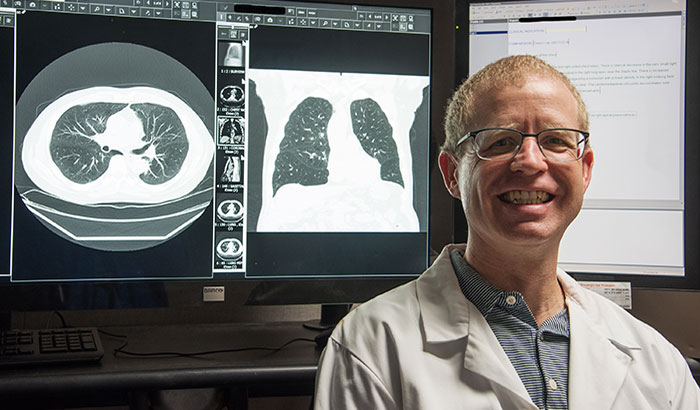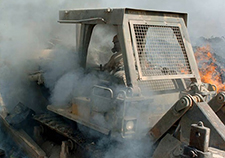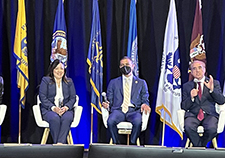Office of Research & Development |
 |


Dr. Christopher Slatore of the VA Portland Health Care System is co-author of a review study that explored patient reaction and doctor-patient interaction in cases when a lung nodule is detected. (Photo by Michael Moody)
October 4, 2018
By Mike Richman
VA Research Communications
It’s not something people want to hear: the detection of a small mass of tissue on the lung. What does this mean, patients ask? Do I have cancer?
Lung nodules are quite common, but most are benign. Still, some doctors, worried that too much distress is harmful to patients, avoid talking about possible cancer. Anxiety, often long-lasting and sometimes severe, is common among patients with pulmonary nodules that are detected unintentionally or during tests for another medical condition. The strategy of withholding cancer information to reduce distress is likely ineffective and can lead to more discomfort.
"Lung nodules are common, but most are benign. A new VA study points to deficiencies in how health care providers communicate with patients about the condition when it is detected."
Those are some of the key findings in a review written by VA researchers who explored patient reaction and doctor-patient interaction in cases when a lung nodule is detected. The researchers suggest ways that people can learn more about nodules and that doctors can best communicate with patients in such circumstances.
Two pulmonary physicians, Dr. Christopher Slatore of the VA Portland Health Care System and Dr. Renda Wiener of the Edith Nourse Rogers Memorial VA Hospital in Bedford, Massachusetts, co-authored the review. It appeared in the online journal Chest in April 2018.
The review is based on findings from 15 studies that Slatore and Wiener conducted on lung nodule evaluation, including two they collaborated on. Both doctors collected data from patients and doctors through interviews and surveys. Slatore carried out his VA-funded work at VA Portland. Wiener, who was funded by the National Cancer Institute, did her research at the VA Boston Healthcare System, the Boston Medical Center, and the Dartmouth-Hitchcock Medical Center in New Hampshire.
Their main outcome was the distress level of patients. They also studied whether patients with lung nodules returned for follow-up evaluations as suggested by their doctors; patient knowledge of nodules; patient satisfaction with his or her clinician; and doctor communication with the patient.

VA Study Documents Health Risks for Burn Pit Exposures

Under Secretary of Health, panel of experts discusses PACT Act impacts for Veterans

Veteran interest in Gulf War Illness reflected in new research study

VA ear surgeon studies management of severe hearing loss in Veterans
Most clinicians know almost all nodules are benign, and many assume that their patients know, too, according to the researchers. But it’s important to clearly communicate the low likelihood of malignancy, because many patients immediately start worrying about whether the nodule is cancerous, both physicians say.
“When patients first heard about pulmonary nodules,” Wiener says, “we found almost universally in our data that they were thinking, `Oh, my God, do I have cancer?’ Obviously, they were scared. But over time, they took cues from their clinician. As they were getting follow-up scans and the size of the nodule wasn’t changing, their doctor didn’t seem to be making a big deal of it, so patients tended to say, `Oh well, maybe this isn’t something I should be so worried about.’ Eventually, most of them came to terms with the diagnosis, and it wasn’t that big a deal for them anymore. But a subset of patients remained distressed. They didn’t become reassured in the same way that other patients did. It can take a while for some patients to come to terms with living with a pulmonary nodule.”
The studies suggest that clinicians don’t often ask patients about distress.
“But clinicians have a thousand things to tell their patients,” Slatore says. “If they spend 10 minutes explaining what a nodule could mean, what do they skip talking about? Doctors think, and many patients agree, that nodules are just one problem of many for most of their patients. “Many patients in our studies seem to figure that out, saying things like, `My doctor doesn’t seem freaked out. Why should I?’”
Every year, millions of patients are diagnosed with lung nodules, which are commonly known as a “spot on the lung” or a “shadow.” They are found in up to half of adults who get a chest X-ray or a CT scan and appear as round white shadows that are more solid than normal lung tissue. Less than 5 percent of those detected turn out to be cancerous. (A CT scan, formerly known as a CAT scan, is a way to make multiple X-ray images of parts of the body.)
Most nodules are small enough that they don’t cause symptoms, so finding them frequently comes as a surprise. They are often the product of scar tissue, a healed infection that never made someone sick, or an irritant in the air.
Slatore and Wiener say it’s often best to watch a small nodule—once it’s first detected—by getting a CT scan every 6 to 12 months, a form of active surveillance. Most small nodules grow slowly even if they are cancerous, so it’s usually safe to wait that long. If a nodule doesn’t grow or change over a two-year period, it’s unlikely to be cancerous.
Nodules can be up to 30 millimeters (1.18 inches or three cherries) in size. A biopsy, a procedure in which a piece of the lung is removed to analyze it for cancer under a microscope, is sometimes done for nodules that are 9 millimeters or larger. But a biopsy is usually not practical when nodules are very small. In such cases, the procedure can cause the lung to collapse, bleeding, or an infection.
Slatore and Wiener suggest that once a small pulmonary nodule is found, the doctor should say something like this to the patient:
“You have a pulmonary nodule, which is a spot on your lung. It could be, but probably isn’t, a very small but dangerous form of lung cancer. I would like you to get a CT scan in six months to see if the nodule has changed. We hope it’s not cancerous. But if it is, we don’t expect it to spread during that six-month period. It’s often stressful to wait that many months, but we will take care of you. How stressed are you to hear this news and what can I do to make things better?”
So patients don’t have to be totally dependent on clinicians and can learn about lung nodules on their own, Slatore and Wiener created a patient education document for the American Thoracic Society. The group aims to advance the understanding of pulmonary diseases, critical illnesses, and sleep-related breathing disorders.
“It’s probably important to have this knowledge, or to at least have easy access to this information,” Slatore says. “But our research suggests that just having more information about things like what a nodule is and how likely it is to be lung cancer won’t influence stress that much. Probably the most important part of communication to lower anxiety levels is to have clinicians understand and talk about their patients’ values and preferences, learning how stressed they are by the news of the nodule and listening to their questions and concerns. This aspect of communication is probably a key part of what causes patients to trust clinicians. It’s also a much harder habit for doctors to change because of a lack of time or training, or because certain details seem less important to patients.”
In pursuing their respective studies, the two researchers found it critical to evaluate patient-based outcomes after nodule detection. That’s partly because many studies have focused on the impact of cancer detection in patients, but fewer on the psychological effects of a near-cancer diagnosis, they say.
“When we started our research studies, no data existed on the likelihood or magnitude of those harms,” they wrote in the review article. “Thus, we wanted to study how commonly distress occurred, and how severe it was for patients with nodules.”
The researchers found that many patients were distressed after being diagnosed with an incidental nodule. Some reported severe levels of anxiety. For example, one participant said she “bawled through Christmas.” Another said he felt like he’d received a “death sentence.” Many of the patients reported that they immediately assumed they had cancer.
Wiener learned that among patients with an average nodule size of 7 millimeters (the median risk of lung cancer for those nodules is 7.1 percent) who were surveyed up to three years after the nodule was detected, 50 percent reported at least mild distress, with 24 percent experiencing moderate or severe levels. In Slatore’s study, nearly 40 percent of patients with an average nodule size of 6 millimeters (the average risk of lung cancer is 10 percent) reported distress, with 16 percent at moderate or severe levels.
Overall, patients said they were satisfied with communication with their doctors, with many reporting it to be of high quality. But the researchers still found some problems. For one, they learned that almost every person had very little information about his or her nodules. When they first learned of the nodule, many of the participants said, “What do you mean, a spot,” or “What the heck is a nodule?” Many still didn’t know the answer to that basic question months to years after first learning of the nodule, the researchers say.
“The participants implicitly understood that the nodule was related to lung cancer, but very few had an accurate understanding of the level of risk, the plans for surveillance, or the rationale for active surveillance rather than a biopsy,” the researchers write.
In terms of the clinicians, Slatore and Wiener note that they used various strategies to decrease stress. But the decision by some of them to purposely not talk about cancer, while well-meaning, was glaring. Patients across the board asked for more information about nodules, and those who received it more often found this information reassuring instead of upsetting, according to the review.
In their review, Slatore and Wiener share tips on how clinicians can improve communication with patients, such as:
While deficiencies clearly exist in doctor-patient communication when it comes to lung nodule detection, they aren’t unique to that field of medicine.
“It’s a widespread problem throughout the medical community,” Wiener says. “It’s been shown in studies of all types of clinical contexts that clinicians don’t spend as much time communicating information that patients would like to know, taking time to answer their questions, and fleshing out their values and preferences. Most studies on doctor-patient communication tend to show that we’re rushing through clinical visits and doing things like interrupting patients and not taking the proper time to address patient concerns.”
In Slatore’s view: “We can clearly do a better job of communicating information to our patients. But I think it’s much harder to decrease distress. We found out, for example, that more knowledge wasn’t associated with better adherence to doctor recommendations to get a CT scan every six months. But better communication, in general, was. I’ll take that tradeoff.”
VA Research Currents archives || Sign up for VA Research updates